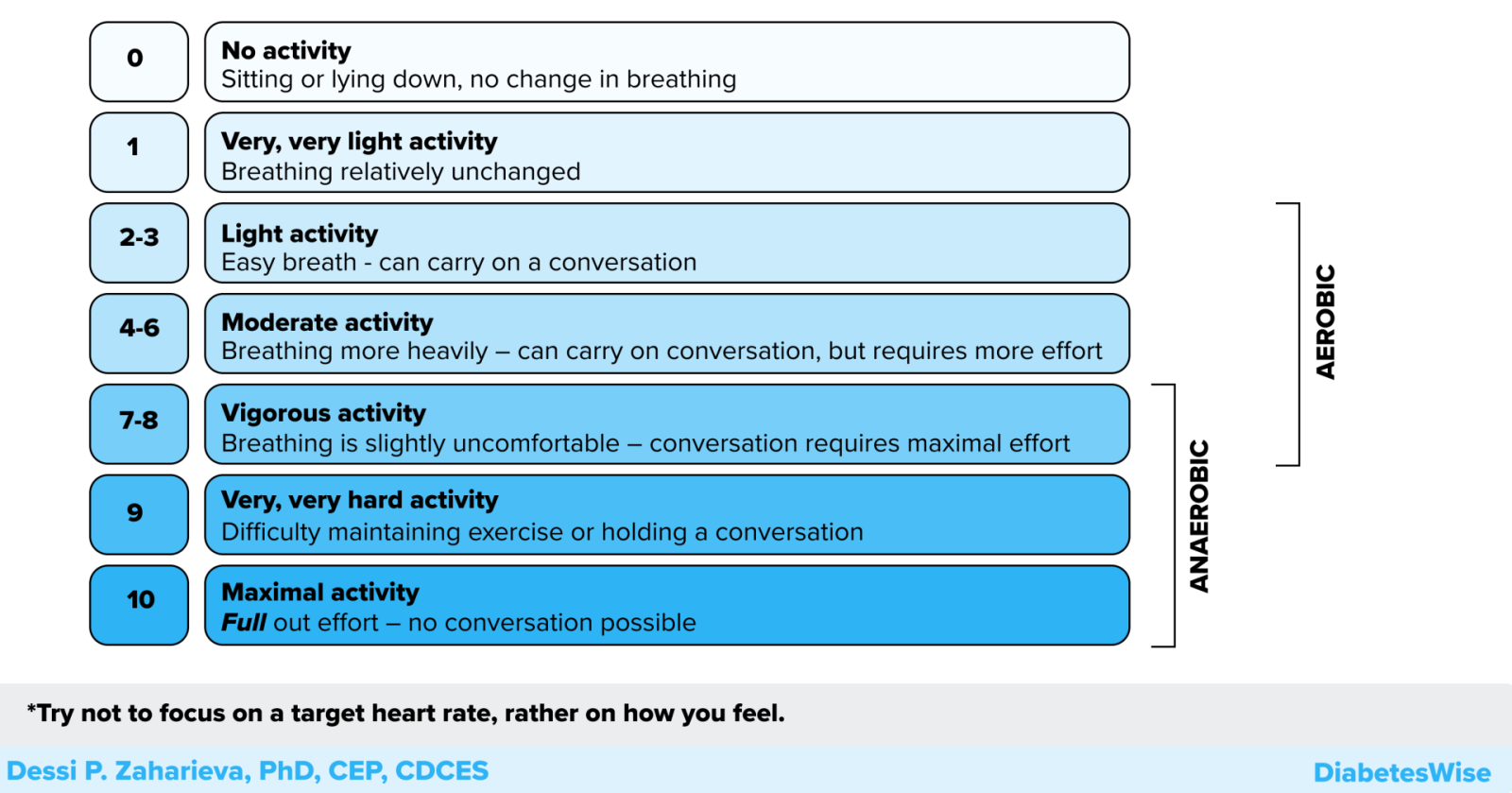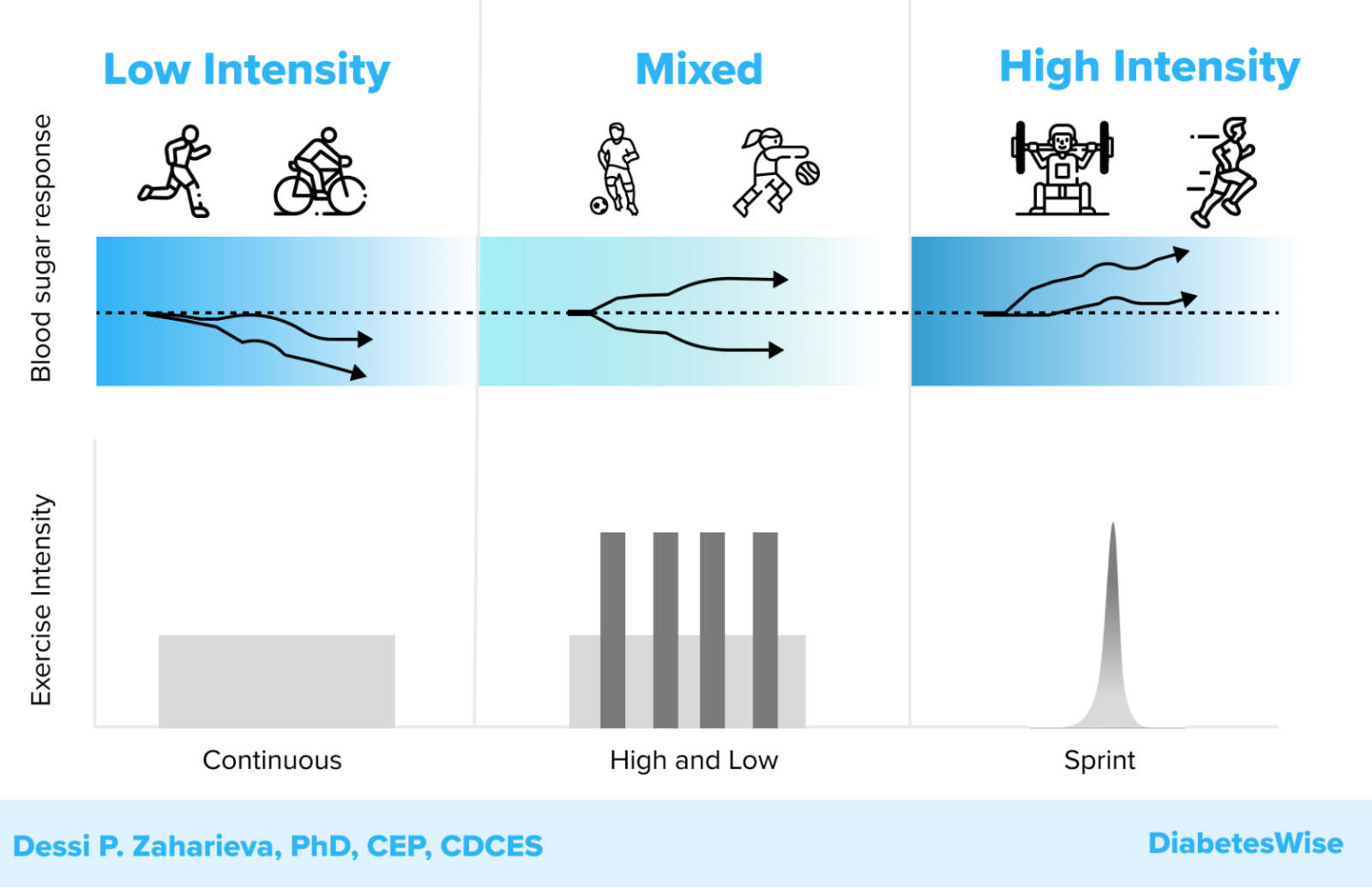Exercise
Understand Intensity
Understanding Exercise
For people with type 1 diabetes, aerobic exercise (like walking, jogging, and cycling) can lower glucose levels. Some anaerobic exercises (like sprinting and power-lifting) can raise glucose levels. But it can be hard to know how intense an activity is.
Here is a modified "Rating of Perceived Exertion (RPE)" scale to help understand what intensity you are exercising at:
- Aerobic activities usually fall in the 2–8 range
- Anaerobic activities usually fall in the 7–10 range

The type and intensity of exercise can affect glucose levels differently. Below, we describe different intensities of physical activity and how they may impact your glucose levels.
LOW TO MODERATE INTENSITY ACTIVITY
- Glucose levels tend to drop with low-to-moderate intensity activity.
- Your body uses up energy, and as you use it, you may experience low glucose levels.
- You may need a snack before or during the activity to prevent lows.
MIXED ACTIVITY
- A combination of low and high-intensity activity (sometimes in short bursts or intervals).
- Mixed forms of exercise usually cause a smaller drop in glucose levels.
- You may still need a snack before or during the activity to prevent lows.
HIGH-INTENSITY ACTIVITY
- Very explosive, high-intensity, or anaerobic exercise may cause glucose levels to rise.
- Maximum effort activity (to fatigue) can cause the liver to release more glucose than muscles take up.
- Increases in stress hormones (like adrenaline) in the body may cause glucose levels to rise.

Below, we give examples of light-, moderate-, and vigorous-intensity activity for youth and adults living with diabetes.
Intensities of Activity
Youth
Light-Intensity Activities (Activities of Daily Living/ADL's):
Walking to/from school
Walking in between classes
Stretching
Moderate-Intensity Activities
Physical education (PE) class activities
Playing on the playground
Volleyball
Soccer
Football
Basketball
Ultimate frisbee
Vigorous-Intensity Activities
Beep test at school (sprinting)
Mile run at school
Tag (a school game involving one or more players chasing other players in an attempt to "tag" and mark them out of play)
Intensities of Activity
Adult
Light-Intensity Activities (Activities of Daily Living/ADLs):
Walking
Getting groceries
Cutting the grass
Vacuuming
Doing laundry
Moderate-Intensity Activities
Walking briskly (2.5 miles per hour or faster)
Recreational swimming
Bicycling slower than 10 miles per hour on level terrain
Tennis (doubles)
Active forms of yoga (for example, Vinyasa or power yoga)
Exercise classes like water aerobics
Vigorous-Intensity Activities
Running
Bicycling faster than 10 miles per hour
Tennis (singles)
Visit these sections for more information
References
Adolfsson P, Taplin CE, Zaharieva DP, Pemberton J, Davis EA, Riddell MC, McGavock J, Moser O, Szadkowska A, Lopez P, Santiprabhob J, Frattolin E, Griffiths G, DiMeglio LA. ISPAD Clinical Practice Consensus Guidelines 2022: Exercise in children and adolescents with diabetes. Pediatr Diabetes. 2022 Dec;23(8):1341-1372. doi: 10.1111/pedi.13452. PMID: 36537529; PMCID: PMC10107219.
Riddell MC, Gallen IW, Smart CE, Taplin CE, Adolfsson P, Lumb AN, Kowalski A, Rabasa-Lhoret R, McCrimmon RJ, Hume C, Annan F, Fournier PA, Graham C, Bode B, Galassetti P, Jones TW, Millán IS, Heise T, Peters AL, Petz A, Laffel LM. Exercise management in type 1 diabetes: a consensus statement. Lancet Diabetes Endocrinol. 2017 May;5(5):377-390. doi: 10.1016/S2213-8587(17)30014-1. Epub 2017 Jan 24. Erratum in: Lancet Diabetes Endocrinol. 2017 May;5(5):e3. PMID: 28126459
Zaharieva DP, Morrison D, Paldus B, Lal RA, Buckingham BA, O'Neal DN. Practical Aspects and Exercise Safety Benefits of Automated Insulin Delivery Systems in Type 1 Diabetes. Diabetes Spectr. 2023 May;36(2):127-136. doi: 10.2337/dsi22-0018. Epub 2023 May 15. PMID: 37193203; PMCID: PMC10182962.

